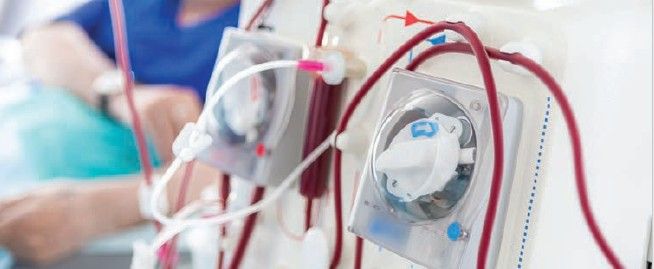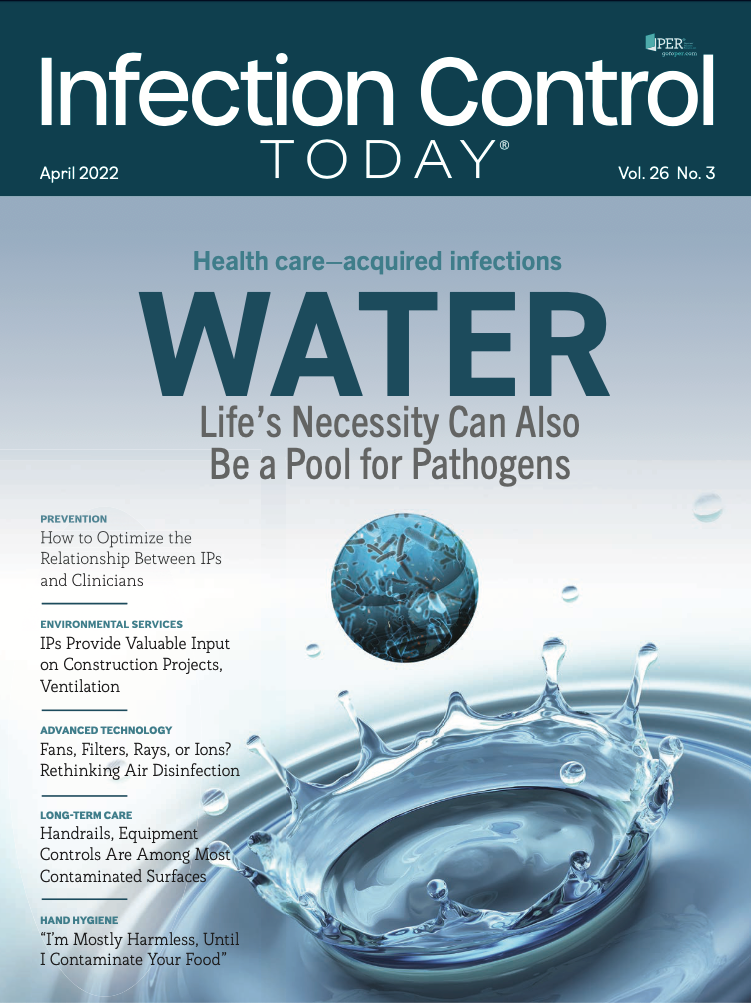Infection Prevention and Control Are Crucial in Dialysis Settings
The hemodialysis setting presents a challenge for environmental cleaning and disinfection because of the demand for rapid turnover of stations.
(Adobe Stock)

There are more than 700,000 individuals in the United States with end-stage kidney disease (ESKD) and the prevalence is estimated to be increasing by 20,000 cases a year.1 The treatment of choice for ESKD is kidney transplant but, because of a lack of available organs, most patients will rely on dialysis as a life-sustaining measure. Dialysis replaces many functions of the kidney by removing wastes and excess fluid through natural (peritoneum) or artificial (hemodialyzer) membranes. Most patients in the United States currently receive treatments using hemodialysis (HD) that is performed in outpatient clinics 3 days per week, but use of alternate sites such as long-term care facilities or the patient’s own home is growing in popularity. Regardless of setting, the process of dialysis poses unique challenges to infection prevention and control. Some of the most impactful practices for preventing infection are discussed below.
Bloodstream Infection
Infection is a leading cause of hospitalization and the second-leading cause of death in patients on dialysis. The process of HD puts patients at risk because the normally sterile bloodstream must be accessed several times per week. The risk varies with the type of device used to access the bloodstream, with a central venous catheter (CVC) carrying a risk 7 times higher than that of a native vessel called arteriovenous fistula (AVF).2 Reducing risk requires optimal care of the access site, such as using chlorhexidine gluconate for skin antisepsis, disinfecting CVC hubs before access, and keeping the exit site clean and dry. The CDC has published a set of evidence-based practices called Core Interventions for Dialysis Bloodstream Infection Prevention that have been shown to reduce risk of bloodstream infection in patients on dialysis by about 50%.3 Dialysis facilities should ensure that these interventions are incorporated into their policies and practices.
Despite a focus on decreasing catheter use and increasing use of AVFs, many patients receive dialysis through a CVC, which increases their chances of catheter-related bloodstream infection and potential need for antibiotic therapy. Annually, it can be expected that intravenous antibiotics will be administered to approximately 1 in 3 patients receiving maintenance HD. Frequent antibiotic administration may increase the likelihood that the patient becomes colonized or infected with a multidrug-resistant organism and faces challenges of antibiotic resistance. Inappropriate use and overuse of antibiotics are also associated with Clostridioides difficile infections.
Standard and Transmission-Based Precautions
The proximity of patients on dialysis to one another and to health care workers can increase transmission of infection. Standard precautions can reduce risk of transmission of many common germs when used for every patient encounter across the continuum of care. The practices included in standard precautions are hand hygiene, use of personal protective equipment, respiratory hygiene, appropriate patient placement, careful handling of textiles and laundry, and safe injection practices.4 Chief among these is hand hygiene, which has long been a cornerstone of infection prevention and control. Alcohol-based hand sanitizer is more convenient and efficient than handwashing with soap and water and is the preferred hand-sanitizing product for these types of care settings.
Transmission-based precautions are used to prevent spread of certain germs through direct or indirect contact, respiratory droplets, or airborne particles. Respiratory illnesses such as influenza or COVID-19 can rapidly spread in congregate settings such as a dialysis clinic. Identifying infected patients and quickly implementing droplet respiratory precautions can prevent transmission of respiratory viruses between patients. Infections requiring airborne isolation (such as tuberculosis) are not as easy to manage in dialysis because the use of negative pressure and respirators is not routinely available in the outpatient setting.
Contact transmission is known to play a major role in the spread of bloodborne pathogens such as hepatitis B (HBV). HBV can survive for long periods on surfaces outside the body, and it is through this mechanism that chronically infected patients can infect others. Patients with HBV and the equipment used to treat them are isolated from susceptible patients on dialysis. Hepatitis C (HCV) and HIV are not as easily transmitted as HBV, and these patients and their equipment do not have to be isolated. Contact precautions are not routinely recommended for patients on dialysis who are infected or colonized with multidrug-resistant bacteria. This is mostly because contact transmission is not well documented in HD centers; it occurs less frequently in these settings than in hospitals, and environmental contamination is also less likely in dialysis facilities than in acute care settings because the patient is in the facility for a relatively brief period.
Screening and Immunization
Screening is an important tool for detecting disease early and preventing transmission, especially when cases of infection have been epidemiologically linked to transmission in dialysis facilities. It is recommended that all new patients on dialysis be screened for HBV, HCV, and tuberculosis. This allows patients to be treated or isolated before there is opportunity to transmit the infection to others. After initial screening, it is recommended to continue screening for HCV every 6 months. Any newly identified HCV in a dialysis population should be reported to the local health department and investigated for potential transmission within the dialysis facility.
Immunization is an effective way to provide protection to susceptible patients. Patients on dialysis have a high incidence of respiratory infection with mortality rates significantly higher than the general population, and it is recommended that they be vaccinated against pneumococcal disease, influenza, and COVID-19. Additionally, if found to be nonimmune to HBV during screening, the HBV vaccine series is recommended. Immune response to vaccines in patients with ESKD is less robust than in healthy individuals because of changes in the immune system. Vaccine dose and administration schedules are different for patients with ESKD than for others, and it is important to review dosage and vaccine schedule for this population.
Cleaning and Disinfection
The HD setting presents a challenge for environmental cleaning and disinfection because of the demand for rapid turnover of stations. Dialysis center staff often feel rushed to complete tasks, especially when transitioning patients on or off machines. Under these pressures, personnel may eliminate or take shortcuts in steps essential for preventing infection transmission. If contaminated surfaces that are turned over quickly are not adequately cleaned and disinfected, bloodborne and other pathogens may remain alive and infectious for days. Dialysis centers should allow adequate time between patients for thorough cleaning and disinfection.
All surfaces of the dialysis station, including the machine and patient chair, should be cleaned and disinfected using a United States Environmental Protection Agency–registered hospital disinfectant. Cleaning and disinfection should commence once the patient has left the station to prevent cross-contamination. Internal surfaces of the dialysis machine should be regularly disinfected following the manufacturer instructions for use. Written protocols outlining the steps should be in place, and the use of a log can help to document and keep track of cleaning and disinfection. Elsewhere in the facility, clean and contaminated areas should be separated, with clean supplies and medication preparation areas having adequate spatial separation from contaminated equipment storage.
Water Safety
Water safety is extremely important in the dialysis setting. Potable water from municipal systems often contains a small amount of bacteria harmless when ingested because of the inhospitable environment of our stomachs. However, even a minute number of normally harmless bacteria in the water poses a great risk of infection to the patient on dialysis because the bacteria bypass the normal protection of skin and stomach acid and are directly introduced to the bloodstream during dialysis. An additional consideration is that, in HD, patients’ bloodstreams are exposed to 300 to 600 L of water per week during treatments; a small number of bacteria normally allowed per liter of water is quickly magnified given the volume of water exposure.
These are a few reasons why water quality is strictly monitored in the dialysis setting. Water systems are specially engineered to further soften and filter the municipal supply to ensure that toxins like chlorine and endotoxin, and hazards like bacteria and sediment, are removed. Alternatively, reverse osmosis portable water systems may be used in some settings, but the objective is the same: to have the purest water possible. Chemical and biological standards established by the Association for the Advancement of Medical Instrumentation give allowable and action levels for each hazard. Routine monitoring of bacteria and endotoxins in product water, along with periodic disinfection of the water system, is recommended.
Practice Audits
Effectiveness of infection prevention and control techniques requires that interventions be consistently applied and reliably followed. Staff should be well trained on hire and competency routinely assessed. Whether staff receive education through a formal trade school or college or on-the-job training, it is important to provide annual training to ensure competency is maintained. Provide training on an ongoing basis for new products and policies. Hand hygiene observations should be performed to monitor for adherence, and the monitoring results should be shared with staff. Discussion of the results and reinforcement of best practices are extremely important.
The facility’s competency program should cover the Core Interventions for Dialysis Bloodstream Infection Prevention identified by the CDC as proven methods for improving care and reducing bloodstream infections. Adherence is more likely if the order in which steps are to be performed is standardized. A checklist of steps can help to ensure adherence and can be used to assess and provide feedback on performance. The CDC has a series of checklists and audit tools that may be used in dialysis centers for this purpose.4
Conclusion
Dialysis is a life-sustaining treatment for individuals with ESKD; however, infection continues to be a major cause of morbidity and mortality in this population. Several agencies and work groups have published guidelines to help reduce the risk of infection in the dialysis setting. However, research has shown that these recommendations are not uniformly implemented nor followed in some facilities. Each member of the dialysis team has a responsibility to ensure that prevention practices are in place and followed, and the role of the infection preventionist is often delegated rather than dedicated. Because of this, dialysis facility leaders should ensure that there is training on hire and annually and that competency is periodically assessed to protect patients from avoidable harm.
References
- Saran R, Robinson B, Abbott KC, et al. US Renal Data System 2016 annual data report: epidemiology of kidney disease in the United States. Am J Kidney Dis. 2017;69(3 suppl 1):A7-A8. doi:10.1053/j.ajkd.2016.12.004
- Hoen B, Paul-Dauphin A, Hestin D, Kessler M. EPIBACDIAL: a multicenter prospective study of risk factors for bacteremia in chronic hemodialysis patients. J Am Soc Nephrol. 1998;9(5):869-876. doi:10.1681/ASN.V95869
- Dialysis safety: core interventions. CDC. Updated June 15, 2016. Accessed February 11, 2022. https://www.cdc.gov/dialysis/prevention-tools/core-interventions.html
- Dialysis safety: audit tools and checklists. CDC. Updated September 25, 2017. Accessed February 11, 2022. https://www.cdc.gov/dialysis/prevention-tools/audit-tools.html

Robust infectious disease surveillance, including rapid subtyping of influenza A, is essential for early detection, containment, and public health reporting of novel viral threats.